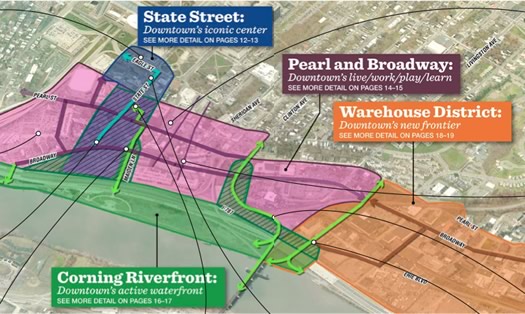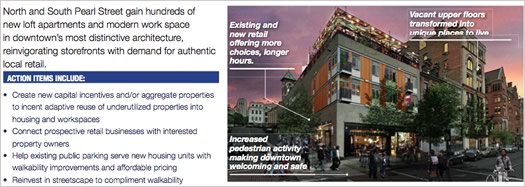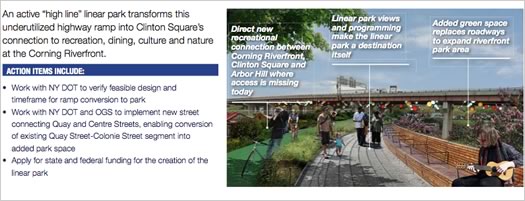Impact Downtown Albany's vision of what the city's downtown could be

The study identified four zones in downtown Albany.
This week Impact Downtown Albany -- the ongoing project to develop a "tactical" plan for downtown development -- released its vision of what downtown Albany could become over the next 5-10 years.
"This is the shared definition of success based on the hundreds of stakeholders that have been part of this process," Sarah Reginelli -- the new president of Capitalize Albany -- explained to us Tuesday afternoon. "This is really what's been identified as the opportunities that we need to take advantage of to make downtown the best downtown that it can be at this point."
Among the identified possibilities: continued growth of new housing units, unique retail, a "high line"-type park connecting downtown with the riverfront, and transformation of part of the warehouse district.
Here are a few things that caught our attention.
The images are from the briefing book embedded below. So... don't squint too much.
Residential

Downtown Albany has been a hot spot for new (and converted) residential over the last few years, with about 300 new units that are almost all rented. The consultants working for Impact Downtown Albany see no stop to that. In fact, they project that downtown Albany could add more than 2,000 more units over the next decade.
One of the factors pushing demand for these units: people from outside Albany. About 3/4 of the people who have moved into those new units are from outside the city, according Ben Carlson from Goody Clancy, the lead consultancy on the project.
"It's not just here, it's all kinds of places have a fixed image of downtown that it's old, unsafe," said Carlson. "That is often not shared by folks moving in from other cities, moving upstate from New York City, folks who are young. That new energy and enthusiasm looks past some of those ideas that locals may be stuck with and really sees opportunities. They see beautiful buildings, walkable streets, plazas that have potential. So that's a powerful force."
Up to this point, most of the new residential development has been at the higher end of the market, with rents averaging $1.38/square foot, according to Reginelli. Developers have said those types of units are currently what make sense from an economic perspective.
Those sorts of rents are a good sign of strength for the downtown market. But they also close off the neighborhood to a lot of people.
Reginelli acknowledged one of the next steps is filling out other segments of the housing market: "Our challenge now is to get to that workforce housing, what's between affordable and the high end of the market, to get service workers, the people who are working downtown who can't afford a $2,000 apartment."
She said some units of that type are in the process of being developed, and more are in planning stages.
Retail
Retail development has been a challenge for decades not just in downtown Albany, but in many downtown areas all over the nation, as suburbanization pushed people and stores away from urban cores.
Reginelli said Capitalize Albany has been in discussion with "national retailers, names that you would absolutely know," along with prominent regional brands about locating downtown. But she emphasized that finding the right fit between retailer and neighborhood is important. And that means some types of retailers -- like, for example, a large supermarket -- are probably not a match at this point.
"Downtown is not going to be everything to all people to all retailers," said Reginelli. "That sort of large floor plate model is not necessarily suited to a smaller downtown. But it's really about coming up with what we need, and what can be sustainable and supportable ... Is it the large floor plate, or is it a speciality destination market that can serve the daytime community as well as the growing residential population, and can have other amenities -- coffee, can it be a wine bar, can it do other things that can help support itself."
Warehouse district

As we've mentioned before, Albany's Warehouse District presents some interesting opportunities for residential/restaurant/retail development -- and also some significant challenges. The neighborhood's gathering momentum caught the attention of Impact Downtown Albany.
"So we wanted to make sure, as really the energy started building in that district, that it complimented the activity in downtown, one," Reginelli said. "Two, that it wasn't disrupting those longstanding businesses that have been thriving in the warehouse district for decades. And the third piece is that it's really meeting its full potential. What can we do to help facilitate that groundswell of activity that's happening there."
Finding the right balance between new development and the neighborhood's long-established light industrial businesses could be a challenge.
"So we need to do a lot more work in that area ... what is that balance, and how does that play out throughout the zoning and though the development pattern in the area. And that will come out through the city's re-zoning process. We'll partner with them on that to work through it."
(Mayor Kathy Sheehan's office announced on Wednesday that it's hired an outside firm to head up a two-year citywide process to overhaul zoning aimed at making the city "a better place to live, work, and invest.")

Incentives
Tax breaks are a hot topic in Albany because developers say projects in the city are too expensive without them -- and skeptics are concerned that big developers are being handed too much.
The Impact Downtown Albany project identified costs -- both in taxes and building acquisition -- as one of the primary obstacles to continued to development downtown. And it looked at some of the tax breaks -- including PILOTs -- that have been used to push the math more in the direction of what developers say is necessary to make a project work. Its conclusion: the tax breaks are worth it for the city after all the costs and benefits are weighed.
"Yes, that approach forgoes some property revenue for a time," said Goody Clancy's Ben Carlson. "But on balance, when you look at the added cost to the city in police and fire services primarily, and revenues, because there are still some other revenues from increased retail sales revenue, there's some property tax revenue that comes, there are fees -- we've found it's a net positive impact on the city. And over time as the tax abatement sunsets, then there is a revenue stream from the housing."
That this study would put tax breaks in a positive light isn't surprising -- it's a project aimed at spurring development. When you're a hammer, things tend to look like nails. That doesn't mean it should be discounted -- just that it merits a bit of good-natured skepticism. We're curious to see more about the assumptions and calculations involved in the analysis.
A new and interesting angle to this topic: Capitalize Albany is starting work to put together $10-$20 million that could be used to set the stage for development, or give projects a nudge. Reginelli said they're aiming to raise this money from a wide group of funders -- from the state, to non-profits, to corporations, to foundations, to even slicing off a part of the sales and hotel taxes.
"[The money] can be applied to side grants, it can be applied to an acquisition fund, it can be applied to fit-out assistance. Really looking at things that can level the playing the field to make investment happen," said Reginelli. "The more than we can offer on that [grant] side, the less we have to offer on the tax break side."
The briefing book
The briefing book released this week is embedded below.
Impact Downtown Albany Briefing Booklet
Earlier
+ Impact Downtown Albany
+ Six short takeaways from six short talks
+ Thinking about residential development in downtown Albany
+ About retail in downtown Albany, and other local downtowns
+ Pop. Pop. Pop. Shop.
+ What "they" say about here
Hi there. Comments have been closed for this item. Still have something to say? Contact us.
Comments
I can't wait for that U2 show at Corning Preserve!
There are some interesting ideas, but this document doesn't seem to address the biggest potential game changer: we need to have a serious conversation about turning 787 into a street level boulevard.
... said Mike on Oct 29, 2014 at 10:25 PM | link
These wishlists are always a dime a dozen and never come to fruition, but that Warehouse District picture looks like Granville Island in Vancouver. There's also a ripoff of NYC's highline trail. Why not learn from the best? Consider me won over.
... said Ryan on Oct 30, 2014 at 7:47 AM | link
LOVE the 787 overpasses in the background of the renderings. Makes the boulevard so homey feeling. Mike - I'm afraid U2 had to cancel, but a Hall and Oates cover band has agreed to fill their slot!
... said ace on Oct 30, 2014 at 8:50 AM | link
Sure, the math on all of the tax breaks might work out in isolation, but that doesn't consider the behavioral changes that they bring about. First: these big development companies get so used to them that they refuse to tackle any project that doesn't include massive tax incentives. Second (and more important): as somebody who is interested in developing downtown and possibly starting a business there, but isn't Columbia development, what message do those tax breaks send to me? The smaller players who will do the type of infill, mixed use development that we really need get discouraged when they see that only the big guys get any support from the city and that the playing field is tilted against them. We should disband the IDA and all similar nonsense and use that money to lower taxes for everyone equally.
... said Mike D on Oct 30, 2014 at 9:29 AM | link
Why is it that when I lived in many small to medium sized European cities there were no "teams of consultants" and endless meetings and zoning changes and blah blah? They just seemed kinda able to build nice walkable, liveable, safe, clean, functioning cities with shopping and restaurants and transit and on and on without all these studies being done ad infinitum??We have a whole industry of so called consultants but NO ACTAUL product. They seem to have a decent PRODUCT with little actual consultants!
... said BS on Oct 30, 2014 at 1:23 PM | link
BS, the answer is postwar government policies combined with Europe's long history. For example, there's no Renaissance Schenectady, but a bunch of old cities that grew in the industrial age. After WWII, we subsidized suburbia and automobile travel to the detriment of cities, which we often razed instead. We're likely still approaching the turning point in reversing such horrible decisions, but unfortunately, this is part of that turning point.
... said JayK on Oct 30, 2014 at 1:50 PM | link
Please allow me to squeak my wheel.
Great vision, really. It looks and feels like an urbanphile's Christmas list just in time to present to Santa. But, like Raphie in "A Christmas Story" and his beloved official Red Ryder, carbine action, two-hundred shot range model air rifle, I've got just one present on my wishlist. It would be easier if it were up to Santa to deliver. But it's not. And the Livingston Avenue Bridge Walkway is more important.
So where it it?
I see a lot of lines on the map. Good stuff, happy it's there. But action items for visions #10, #12, and #13 come oh so close... one just has to wonder, what's another bullet point
"Work with NY DOT to verify feasible design and timeframe for addition of a bike and pedestrian walkway on the replacement Livingston avenue bridge."
That's all. Not hard, not binding, hey, both Albany and Rensselaer cities and counties passed resolutions in support. So why do I even complain? Yes, it's little. But the whole object of ADVOCACY is to take the theoretical to institutional.
Maybe I need to do a better job, maybe reading between the lines the city isn't committed to backing it, maybe it's an oversight. But it's still too important to leave out of a plan that's intended to be THE catalyst for downtown's renaissance.
... said daleyplanit on Oct 30, 2014 at 3:21 PM | link
Again back to my earlier post huh??? Wtf are talking about?
... said BS on Oct 30, 2014 at 7:53 PM | link
@BS & JayK
I'd like to offer another explanation. I think a significant problem for us is that we are a much more individualistic and self-centered society. Why do we need consultants? Because citizens are not engaged. They are not involved and generally don't commit their time, money or effort towards social goods that are not directly tied to their personal interests. We just don't have a citizenry that could do what BS describes.
Yes. I'm generalizing. I know there are many people that participate and actually contribute to making society a better place. (Many of those posting on AOA, in fact.) I hate being cynical like this, but I can't help but feel that we have deep-seeded cultural challenges that make what you describe a challenge.
As much as I hate to compliment Millenials, they do seem to be moving in a more socially conscious direction. So, who knows? Maybe we can get better. We're just not there yet.
... said Jay on Oct 30, 2014 at 9:04 PM | link
On one hand, I do agree with previous commenters that this is an urbanphiles wishlist come true. On the other, I get cynical about how we will achieve this, given how slow government AND the business community move on such initiatives, and more importantly, the apathy often exhibited by the citizenry. Then again, Albany has put together some pretty good neighborhood and citywide (Albany 2030) plans, which espouse some pretty big, significant changes. While these plans aren’t getting executed overnight, they are get executed (for instance, the Park South Urban Redevelopment Plan—despite some reservations on the parking garage piece by many—or the Arbor Hill, which now has seen two park overhauls and the “Albany Barn†serving as a neighborhood catalyst). Therefore, I’ll hold my breath on seeing big changes overnight, but am thrilled that a 5-10 year vision is being planned for and will be executed at such a pace.
In terms of this apathy, which has been discussed against Europe’s commitment to its cities, or as many in the region term the “Smallbany Problem†I think it is a problem largely unique to American culture, the reasons for being diverse and many. Me personally, having German family members, who are engaged in every issue big and small, it does get me disappointed in my own community, where we can barely get voter participation on significant budget issues (school or library budget) above the 30% mark, and even the voter rates on gubernatorial races (outside of a Presidential election) is shocking. I do agree, maybe as biased as I am as a millennial, that the younger generation is much more collaborative, has embraced social media (to include crowdsourcing and SeeClickFix your government apps), and tend to show up to important visioning meetings like the ImpactAlbany. And for that, I remain positive about our region’s cities, which are witnessing a sea change in investment and population growth after decades of being leached dry by the suburbs.
... said Rich on Oct 31, 2014 at 9:29 AM | link
I like that they have plans in the works and seem to be vetting out numerous angles and solutions. In addition to the residential, retail and restaurants, I hope they’re considering incorporating more visual arts.
... said J on Oct 31, 2014 at 10:17 AM | link
I always thought that that area of downtown could be an awesome residential neighborhood. It has both wide and bright streets and alley-like streets to give it a lot of charm. The architecture around that area is also impressive. I hope that the city finds investors for this plan, but I also share some of Mike D's concerns above. If the usual sharks do not have a seat at the table, other investors are shunned (although I think that our new mayor will be changing that as she gets more comfortable with her new job).
... said Joe A on Oct 31, 2014 at 12:20 PM | link